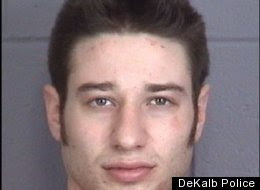Bills are currently pending in seven states (AZ, GA, MI, OH, OK, SC, TN) that would restrict the ability of America’s colleges and universities to regulate firearms on campus (at least five other states have considered similar legislation during the past year). The gun lobby continues to advocate for guns on campus despite overwhelming opposition from the American public, university officials, and organizations like the International Association of Campus Law Enforcement Administrators and American Association of State Colleges and Universities.
Five stories from the past month go far in explaining why America’s colleges and universities have fought so hard to maintain their strict regulations regarding firearms:
- At 3:20 a.m. on February 19, Brian Mulder, 24, was smoking outside a residence hall at Northern Illinois University (NIU) when Zachary Isaacman, 22, attempted to follow a female resident into the building, “kind of like he was stalking her.” “It looked like she was nervous,” recalled Mulder, the president of the residence hall’s council. Isaacman, an NIU student who lives off-campus, began banging on windows and doors trying to get residents to let him in. Mulder told Isaacman he could not enter the hall because he was not a resident there and instructed him to “cut through the lagoon and go home.” At that point, Isaacman pulled out a handgun and pointed it at Mulder’s face. When Mulder moved to knock the gun away, Isaacman drew back and shot Mulder in the thigh. He was caught minutes later by campus police.
 Isaacman has been charged with two felony offenses (aggravated battery with a firearm and aggravated battery) and a misdemeanor (unlawful use of a weapon). University Police who searched his room at the Phi Kappa Theta fraternity house found at least one AK-47 assault rifle, a revolver, a shotgun, and a large amount of ammunition.
Isaacman has been charged with two felony offenses (aggravated battery with a firearm and aggravated battery) and a misdemeanor (unlawful use of a weapon). University Police who searched his room at the Phi Kappa Theta fraternity house found at least one AK-47 assault rifle, a revolver, a shotgun, and a large amount of ammunition.
Mulder, who is recovering after demonstrating great courage in fulfilling his duties, said, “I’m not really worried about my safety. There’s not a ton of people with guns around here. It just happened to be this one guy. I’m glad nobody else got hurt.”
- At 2:46 a.m. on February 27, officers from the Bloomington Police Department received a 911 call about an individual exposing a handgun at Kilroy’s Sports Bar. Arriving at the location, they found intoxicated Indiana University student Alexander Edward Brill surrounded by five bar employees in an alley outside the establishment.
Moments earlier, Brill was reportedly talking to a woman he knew when he was confronted by five men, who verbally harassed him. Brill responded by drawing a loaded Smith & Wesson .45-caliber semiautomatic handgun and pointing it at a female employee of the bar. When a male employee tried to intervene, Brill pistol-whipped him with the weapon.
Brill, who possesses a permit to carry a concealed handgun from the state of Indiana, faces three preliminary felony charges of pointing a firearm, battery while armed, and intimidation with a deadly weapon.
- On March 2, Ike Dean Atkins, 57, drove his wife to a class at Spartanburg Community College in South Carolina. As he waited for her in the parking area inside his car, Atkins, a concealed handgun permit holder, decided to clean his weapon. During this process, the gun accidentally discharged, shooting him in the hand. “Our concern is the safety of our students, faculty and staff, and emergency response was immediate and great,” said Cheri Anderson-Hucks, the college’s Director of Marketing and Public Relations. Atkins violated state law by having a gun on the school’s property and will be charged.
- Hours after purchasing a gun from the Dakota Territory Gun Show on March 6, University of North Dakota student Brad Uvelhor, 28, accidentally shot himself in the leg with the firearm on university property. It is a violation of the school’s policy to carry weapons on campus—all firearms must be checked in to the University Police Department—and Uvelhor could be charged.
- Jonathan Brett, a Western Connecticut State University student, was arrested in the early morning of March 18 after threatening a patron at Maxwell's Bar in Danbury, Connecticut. Brett allegedly argued with the patron about a woman, telling him, "You don't want me to take my gun out." Brett holds a valid concealed handgun permit from the state of Connecticut. It was illegal for him to have his Walther PPK 380 handgun in a bar. He has been charged with threatening, breach of peace, and possession of a handgun while intoxicated.
It is extremely fortunate that none of these events resulted in loss of life. Far from playing the “hero” in some fantasized conflict with a deranged criminal assailant, the “law-abiding gun owners” in these incidents were themselves the threat to the campus communities around them.


